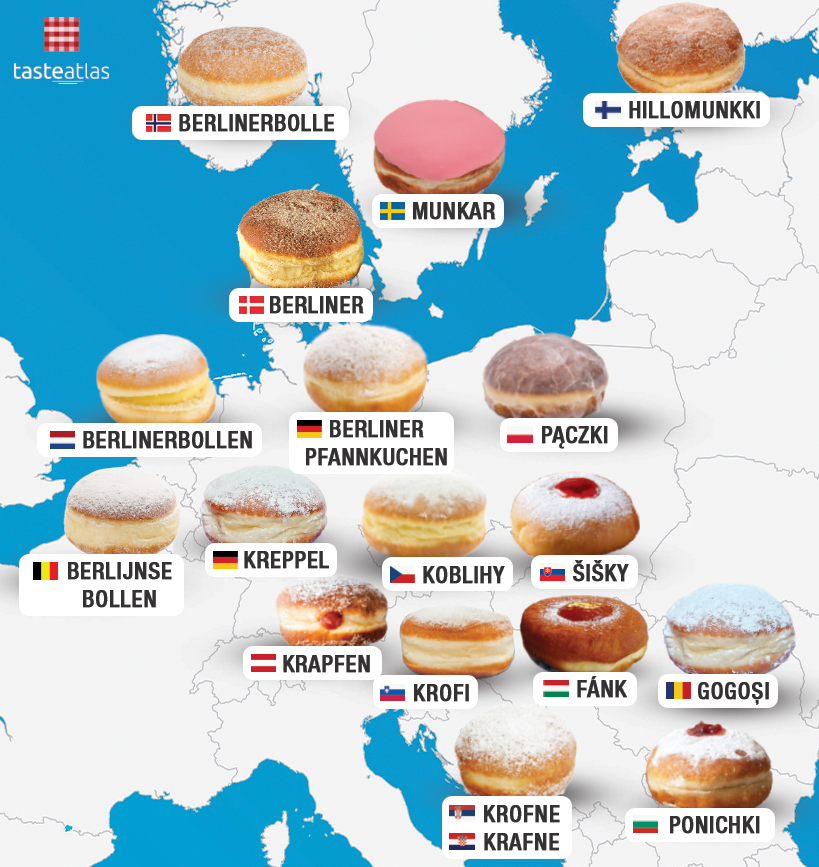Krapfen was probably the first European-style doughnut to appear, followed by similar varieties in other countries. These pastries are traditionally prepared with leavened dough that is deep-fried until golden and crispy on the outside, while they remain soft, light, and airy on the inside.
Though krapfen can be prepared plain, they are most often filled or topped with jams, and vanilla or chocolate custards, while the top is usually dusted with powdered sugar or drizzled with chocolate. The origin of the word krapfen dates back to 9th century, and the recipes in German can be found as early as the 14th century.
This well-known dessert is a traditional dish of Prekmurje, Slovenia’s northeastern region whose recipes have often been inspired by Hungarian and Austrian traditions. According to the Etymological Dictionary of the Slovenian Language, Prekmurska gibanica is a variety of potica, a layered strudel pie characteristic for the eastern part of the country.
The name comes from gibâničnik, a type of pastry basket, or gibâničar, an old Slovenian word for a baker. The oldest written records of Prekmurska gibanica date back to the 1700s when it was first mentioned as gebanza, while another written source from 1828 described it as a dessert that is typically served at weddings.
MOST ICONIC Prekmurska gibanica
View moreKremna rezina is a specialty of the Slovenian Lake Bled area. It is a luscious cream cake with a golden, crispy, buttery pastry acting as its base. The base is topped with flavorful vanilla custard, whipped cream, and a layer of thin, buttery dough.
The whole cake is traditionally dusted with icing sugar and served sliced in cubes. The story of kremna rezina (or Bled cream cake) began with the arrival of chef Ištvan Lukačević to Bled's Park Hotel, where he modified the Hungarian cream cake by adding the right proportions of whipped cream into it, and in 1953, the hotel presented Lukačević's invention to the public.
MOST ICONIC Kremna rezina
View moreMAIN INGREDIENTS
Although they originated as a festive dish that was only served on special occasions, štruklji from Kobarid have become a favorite local dessert that is enjoyed throughout the region. They are prepared with a thin layer of dough and a sweet walnut filling that is enriched with raisins, lemon zest, vanilla, and rum.
When the filling is neatly wrapped, each štrukelj is gently pressed in the middle to achieve its typical shape. It is said that this tradition allows chefs to leave their signature on each handmade štrukelj. These sweet dumplings are best served warm, preferably doused in syrup and dusted with cinnamon, sugar, and ground walnuts, or sprinkled with buttered breadcrumbs.
Commonly known as every Slovenian housewife's source of pride, potica is a traditional cake that is usually prepared for festivities and celebrations such as Christmas and Easter. The cake was derived from the older rolled dough cakes, and it was first mentioned in 1575.
Originally, it was a cake reserved for the upper class, but over the years, it gained popularity with the peasants. There are around 60 types of potica, with various traditional fillings such as walnuts, hazelnuts, tarragon, honey, poppy seeds, and cottage cheese.
MAIN INGREDIENTS
Sirovi or skutni (skutini) štruklji is a traditional variety of štruklji originating from Slovenia. The dough is made with a mixture of flour, water, eggs, oil, and salt. Once rested, it's rolled out into thin sheets that are topped with a mixture of sour cream and skuta (curd cottage cheese).
Sugar and raisins are sometimes added to the mixture, but they're not mandatory. The dough is rolled up into a log, and the štruklji are wrapped in a kitchen cloth and then boiled in salted water until fully cooked. Once they've been taken out of the pot, the štruklji are cut into smaller pieces, and the dish is then enjoyed as it is or topped with breadcrumbs fried in butter.
Prleška gibanica is a traditional cake originating from Prlekija. This version of gibanica is prepared with curd cheese and sour cream. Other ingredients include eggs, flour, sugar, oil, butter, vinegar, salt, and warm water. The dough is rolled into thin sheets, then topped with a combination of curd, eggs, and sour cream in alternating layers.
The last layer of dough is topped with sour cream and a bit of sunflower oil, and the cake is then baked until it's ready to be served. If desired, prleška gibanica can be (once again) topped with sour cream and sprinkled with sugar before serving.
MAIN INGREDIENTS
Pohorska omleta or Pohorje omelet is the most famous dessert of the Slovenian region called Pohorje. It was invented in the Poštarski Dom mountain hut in the middle of the 20th century. The dessert is made with eggs, sugar, vanilla sugar, salt, flour, rum, cranberry jam, whipped cream, and mint liqueur.
In order to prepare it, egg whites, egg yolks, salt, sugar, rum, and flour are made into an omelet which is then baked in the oven. After it has been baked, the omelet is spread with cranberry jam, decorated with whipped cream, and sprinkled with mint liqueur.
As the name suggests, strudelj is the Slovenian version of strudel, which is especially popular in the Vipava area. Since fruit is always at hand in the valley, sweet strudelj is one of the favorite desserts of the locals. Cherry strudelj is the most popular variety, but there are also other varieties prepared with apricots, peaches, pears, plums, and apples.
In late autumn, dainty eaters will surely be delighted by the exceptional persimmon strudelj.
MAIN INGREDIENTS
Different types of gibanica layer cakes can be found in almost every Slovenian region. In Pohorje, gibanica is made with yeast dough and homemade cottage cheese. The cake can be enriched with seasonal ingredients such as dried pears, apples, forest fruits, or tarragon, making this dessert interesting regardless of the time of year.
When Pohorska gibanica has cooled down, and before serving, it is traditionally sprinkled with powdered sugar. It is recommended to serve the cake with moderately strong semi-sweet wines.
TasteAtlas food rankings are based on the ratings of the TasteAtlas audience, with a series of mechanisms that recognize real users and that ignore bot, nationalist or local patriotic ratings, and give additional value to the ratings of users that the system recognizes as knowledgeable. For the “Top 19 Slovenian Desserts” list until April 15, 2025, 1,012 ratings were recorded, of which 734 were recognized by the system as legitimate. TasteAtlas Rankings should not be seen as the final global conclusion about food. Their purpose is to promote excellent local foods, instill pride in traditional dishes, and arouse curiosity about dishes you haven’t tried.



















